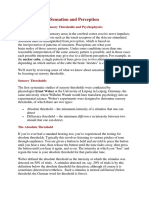Parallel Distributed Model
Uploaded by
Anzala KhanParallel Distributed Model
Uploaded by
Anzala KhanPARALLEL DISTRIBUTED MODEL Definition A model of memory in which memory in which memory processes are proposed to take place
at the same time over a large network of neural connections.(cicarelli & meyer,2008). A theory of the mind that posits a large set of simple units connected in a parallel distributed network,(PDP).mental operations such as memory ,perception, thinking, and so on, are considered to be the distributed throughout a highly complex neuron network, which operates in parallel manner.(solso,2001). In Parallel distributed model ,memory is seen as a simultaneous process, with the creation and storage of memories taking place across a series of mental networks stretched across the brain.(McClelland&Rumelhart,1988;Rumelhart et al.,1986). The theory is based on the assumption that units excite or inhibit each other throughout the system at the same time or in parallel. Parallel distributed model is known as connectionism and neural network. Book on PDP A lot of the research that led to the development of PDP was done in the 1970s, but PDP became popular in the 1980s with the release of the books Parallel Distributed Processing: Explorations in the Microstructure of Cognition - Volume 1 (foundations) and Volume 2 (Psychological and Biological Models), by James L. McClelland, David E. Rumelhart and the PDP Research Group. The books are now considered seminal connectionist works, and it is now common to fully equate PDP and connectionism.
Earlier work PDP's direct roots were the perception theories of researchers such as Frank Rosenblatt from the 1950s and 1960s. But perception models were made very unpopular by the book Perceptions by Marvin Minsky and Seymour Papert, published in 1969. It demonstrated the limits on the sorts of functions that single-layered perceptions can calculate, showing that even simple functions like the exclusive disjunction could not be handled properly. The PDP books overcame this limitation by showing that multi-level; non-linear neural networks were far more robust and could be used for a vast array of functions. Many earlier researchers advocated connectionist style models, for example in the 1940s and 1950s, Warren McCulloch, Walter Pitts, Donald Olding Hebb, and Karl Lashley. McCulloch and Pitts showed how neural systems could implement first-order logic: Their classic paper "A Logical Calculus of Ideas Immanent in Nervous Activity" (1943) is important in this development here. They were influenced by the important work of Nicolas Rashevsky in the 1930s. Hebb contributed greatly to speculations about neural functioning, and proposed a learning principle, Hebbian learning, that is still used today. Lashley argued for distributed representations as a result of his failure to find anything like a localized engram (neuropsychology) in years of lesion experiments. General Characteristics of PDP 1. A network contains basic neuron-like units, which are connected together so that a specific unit has many links to other units (hence the alternate name for the theory, connectionism). 2. A unit may affect other units by either exciting or inhibiting them. 3. Cognitive processes based on parallel operations, rather than serial operations. 4. Knowledge is stored in the association of connections among the basic units.
5. Every new event changes the strength of connections among relevant units. As a consequence, you are likely to respond differently the next time you experience a similar event. 6. Sometimes we have partial remembering for some information, rather than complete, perfect, memory: the brain capacity to provide partial memory is called graceful degradation. The Current Status of Parallel Distributed Processing Approach 1. The PDP approach represents the most important shift in theoretical orientation in psychology. 2. The PDP approach seems consistent with the neurological design of the brain. 3. Many are hopeful that PDP research may provide important, links between psychology and neuroscience. 4. Other researchers are concerned that the PDP approach cannot account for certain memory phenomena. 5. The models have trouble explaining the rapid forgetting of extremely well-learned information that occurs when we learn additional information. 6. The PDP approach is much broader, and it addresses perception, language, decision making, as well as numerous aspects of memory. 7. Each of the first three theoretical approaches- also generated tremendous enthusiasm when they were proposed but the three approaches declined in the recent decades. Still we can speculate whether the enthusiasm that this approach generated will fade or whether PDP approach will become the standard framework for analyzing human memory.
Advantages of the PDP model 1. It allows us to explain how human memory can help us when some information is missing. 2. People can make a spontaneous generalization, which involves making inferences about general information that they never learned in the first place. 3. Spontaneous generalization involves making inferences about a category. (for example, the category called engineering student) 4. PDP model allow us to fill in missing information about a particular person or an object; we make default assignment based on information from similar people or objects.
You might also like
- Unit-1: What Is Organizational Psychology?100% (1)Unit-1: What Is Organizational Psychology?15 pages
- Condensed Guide for the Stanford Revision of the Binet-Simon Intelligence TestsFrom EverandCondensed Guide for the Stanford Revision of the Binet-Simon Intelligence TestsNo ratings yet
- Week 8 Final Project Proposal - Operations Concept ManagementNo ratings yetWeek 8 Final Project Proposal - Operations Concept Management29 pages
- Introduction To Measurement and Scaling TechniquesNo ratings yetIntroduction To Measurement and Scaling Techniques6 pages
- Evaluation of Divided Attention TheoriesNo ratings yetEvaluation of Divided Attention Theories7 pages
- Measures of Visuospatial Short-Term Memory: The Knox Cube Imitation Test and The Corsi Blocks Test ComparedNo ratings yetMeasures of Visuospatial Short-Term Memory: The Knox Cube Imitation Test and The Corsi Blocks Test Compared5 pages
- Ia - Sources of Biases in Psychological TestingNo ratings yetIa - Sources of Biases in Psychological Testing14 pages
- Dr. Ram Manohar Lohiya National Law University: Psychology100% (1)Dr. Ram Manohar Lohiya National Law University: Psychology4 pages
- BSC Psychology Calicut Uty Syllabus 2019No ratings yetBSC Psychology Calicut Uty Syllabus 2019108 pages
- Chapter 5: Memory: Introduction To PsychologyNo ratings yetChapter 5: Memory: Introduction To Psychology6 pages
- ATTENTION - Divided Attention, Selective Attention, Dichotic Listening, Stroop Effect, Filter Theory100% (1)ATTENTION - Divided Attention, Selective Attention, Dichotic Listening, Stroop Effect, Filter Theory3 pages
- New Cancer Treatment? Universal Donor Immune CellsNo ratings yetNew Cancer Treatment? Universal Donor Immune Cells27 pages
- Dementia - Symptoms: Dementia Area of The Brain DementiaNo ratings yetDementia - Symptoms: Dementia Area of The Brain Dementia17 pages
- Letter To Lori Swanson Minnesota AG Concerning Open Records Requests To U of MinnesotaNo ratings yetLetter To Lori Swanson Minnesota AG Concerning Open Records Requests To U of Minnesota2 pages
- Mechanical Design Project Cost EstimationNo ratings yetMechanical Design Project Cost Estimation9 pages
- Pierrot Lunaire and The Resistance To Theory100% (1)Pierrot Lunaire and The Resistance To Theory6 pages
- History and Theory - Is Restoration Actually Modern?No ratings yetHistory and Theory - Is Restoration Actually Modern?2 pages
- Michel Chion Film A Sound Art TranslatedNo ratings yetMichel Chion Film A Sound Art Translated4 pages
- Hologram: Produced by A Split Coherent Beam of RadiationNo ratings yetHologram: Produced by A Split Coherent Beam of Radiation9 pages
- Phase Noise and Jitter in CMOS Ring OscillatorsNo ratings yetPhase Noise and Jitter in CMOS Ring Oscillators14 pages
- Productivity Improvement of A Assembly LineNo ratings yetProductivity Improvement of A Assembly Line88 pages
- Condensed Guide for the Stanford Revision of the Binet-Simon Intelligence TestsFrom EverandCondensed Guide for the Stanford Revision of the Binet-Simon Intelligence Tests
- Week 8 Final Project Proposal - Operations Concept ManagementWeek 8 Final Project Proposal - Operations Concept Management
- Introduction To Measurement and Scaling TechniquesIntroduction To Measurement and Scaling Techniques
- Measures of Visuospatial Short-Term Memory: The Knox Cube Imitation Test and The Corsi Blocks Test ComparedMeasures of Visuospatial Short-Term Memory: The Knox Cube Imitation Test and The Corsi Blocks Test Compared
- Dr. Ram Manohar Lohiya National Law University: PsychologyDr. Ram Manohar Lohiya National Law University: Psychology
- ATTENTION - Divided Attention, Selective Attention, Dichotic Listening, Stroop Effect, Filter TheoryATTENTION - Divided Attention, Selective Attention, Dichotic Listening, Stroop Effect, Filter Theory
- New Cancer Treatment? Universal Donor Immune CellsNew Cancer Treatment? Universal Donor Immune Cells
- Dementia - Symptoms: Dementia Area of The Brain DementiaDementia - Symptoms: Dementia Area of The Brain Dementia
- Letter To Lori Swanson Minnesota AG Concerning Open Records Requests To U of MinnesotaLetter To Lori Swanson Minnesota AG Concerning Open Records Requests To U of Minnesota
- History and Theory - Is Restoration Actually Modern?History and Theory - Is Restoration Actually Modern?
- Hologram: Produced by A Split Coherent Beam of RadiationHologram: Produced by A Split Coherent Beam of Radiation
































































































